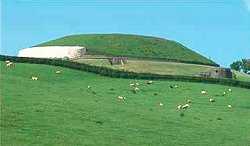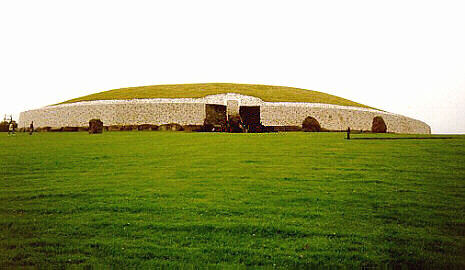

STONE AGE
BUILDING INDEX
STONE AGE
BUILDING
STANDING
STONES
NEWGRANGE
STONEHENGE
MALTA'S MEGALITHIC MARVELS
SKARA BRAE
HUNEBEDDEN
Newgrange
There are a few really remarkable neolithic temples built in those days: one of the best preserved is Newgrange in Ireland. For a long time people thought it was a burial site, until no bones and gifts were found on excavations. Later people found out that this was a sun temple in which the sun shone in at the winter and summer evenings.

According to Van Danniken: "New Grange is an builders masterpiece, an astronomical study as well as a fenomenon in the area of material transport. The complex dates back to a time that the civilization in Egypt were not even begun, and the old cities of Ur, Babylon and Knossos (Crete) were yet to be build. Even the great stone circle of Stonehenge probably did not even exsist when the unknown astronomers build the burial monument of New Grange."
A great site about Newgrange opens with the following text:
"Built some 5,300 years ago, this holy place is one of the oldest built structures in the world. Known in Gaelic as Uaimh na Gréine, 'the cave of the sun', Newgrange is a pagan monument, with a vaulted roof and a cruciform design. Its history is interwoven with intriguing myths and the mysteries of its construction. The lore of its past calls ever-growing numbers of visitors to this chamber of light. Newgrange is at the centre of an entire Boyne valley megalithic culture and religious ritual."

Now, what do 'we' know about Newgrange? I've gathers some facts that might be interesting:
First of all, Newgrange was once known by the name: Si An Bhru. I will use the common name Newgrange on these pages.
Newgrange is considered the most famous of all Irish prehistoric monuments and one of the finest European passage-tombs. Built atop a small hillock, this site was discovered accidentally in 1699.
Newgrange was originally built about 3100 BC and today is in a much restored form. It consists of a vast stone and turf mound about 85 meter in diameter and 13,5 meter high, containing a passage leading to a burial chamber. Outside the base, 12 out of the original estimated 38 large boulders up to 2.4 meter high form a ring of about 104 meter in diameter. The stone circle was built about 1000 years later than the original structure. The base of the mound is retained by no less than 97 large stones, lying horizontally, many of which bear beautifully carved designs of spirals, lozenges, zigzags, and other symbols. The most famous of these is the stone marking the entrance, with carvings of a triple spiral, double spirals, concentric semi-circles, and lozenges similar to those found in Brittany (France), at Gavrinis and of course at the maltese temples in very great numbers.
 Above the entrance passage is a 'roof-box', which precisely aligns with the rising sun at the winter solstice of 21 December, so that the rays touch the ground at the very centre of the tomb for about 20 minutes. Many of the upright stones along the walls of the 19 meter passage, which follows the rise of the hill, are richly decorated. The cruciform chamber inside the mound measures 6.5 x 6.2 meter, has three recesses, and is topped by a magnificent corbelled roof reaching to a height of 6 meter above the floor. In the recesses are three massive stone bassins which presumably had some ritual use. Excavations in the central chamber produced the remains of two burials and at least three cremated bodies as well as seven marbles, four pendants, two beads, a flint flake, a bone chisel, and fragments of several bone pins and points.
Above the entrance passage is a 'roof-box', which precisely aligns with the rising sun at the winter solstice of 21 December, so that the rays touch the ground at the very centre of the tomb for about 20 minutes. Many of the upright stones along the walls of the 19 meter passage, which follows the rise of the hill, are richly decorated. The cruciform chamber inside the mound measures 6.5 x 6.2 meter, has three recesses, and is topped by a magnificent corbelled roof reaching to a height of 6 meter above the floor. In the recesses are three massive stone bassins which presumably had some ritual use. Excavations in the central chamber produced the remains of two burials and at least three cremated bodies as well as seven marbles, four pendants, two beads, a flint flake, a bone chisel, and fragments of several bone pins and points.
Newgrange gets its modern name from the fact that by 1142, the site had become part of Mellifont Abbey farm.These farms were known as granges, and by 14th century the site was known only as the 'New Grange'. In early Irish mythology, Newgrange was not only the alleged burial place of the prehistoric kings of Tara, but also the home of a race of Irish supernatural beings, known as 'Tuatha de Danann': the people of the goddess Danu. You can read that story at this site.
Newgrange was also taken to be the house of the patriarchal god Dagda. Dagda means "good god" but good in the sense of being very skilled rather than in a moral or judgemental sense. This title can also be spelt Daghda or Daghdha and, less commonly, Dagdae or Dagda Mór ("the Great Good God"). He also has some by-names he is known as: Eochaidh Ollathair, which means either "father of many" or "father of all/All-father", and Ruadh Ró-Fheasa meaning "All-knowing noble". This use of the former title in the sources is to show him as a wise ancestral figure.
It may be appropriate to call him a god of the Gaels. He is listed as a leader of the Tuatha De Danaan and was one of the most important deities. In connection with his latter title Dr. O Hogain has noted that the text on the first battle of Moytirra calls him a god of druidry.
The thunder god aspect of this deity can be shown in at least two ways. The myths say of the Dagda: "It was he who used to work miracles for them and to apportion storms and fruits". ('Mesca Ulad' by John Koch & John Carey). This combination of storms, which would include thunder storms, and fertility is most typical of a thunder god archetype. Another indicator is the clear similarities which can be drawn with the Norse thunder god, Thor.
NEWGRANGE STONEHENGE MALTA'S MEGALITHIC MARVELS SKARA BRAE